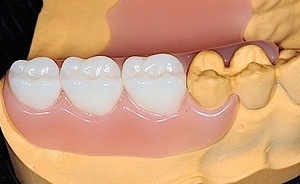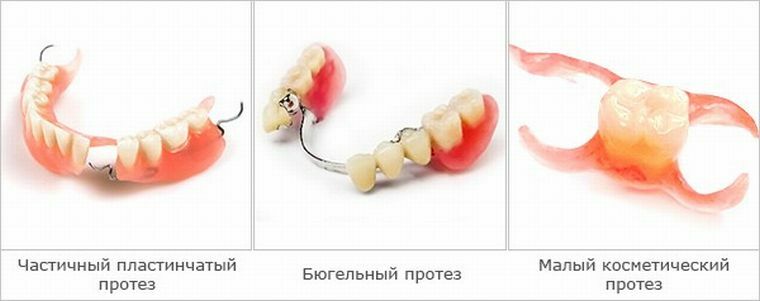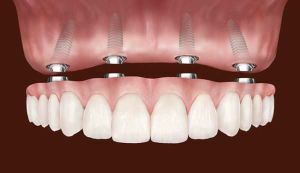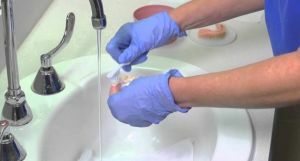 Modern plate prostheses make life easier for those people whose dental system looks far from the best and needs to be restored. The materials from which such constructions are made have many positive qualities.
Modern plate prostheses make life easier for those people whose dental system looks far from the best and needs to be restored. The materials from which such constructions are made have many positive qualities.
Among them we can distinguish such: flexibility, elasticity, strength and aesthetic appearance. Dentists recommend using this method of prosthetics with complete or partial loss of the dentition.
Contents
- Types of plate prostheses
- Application field
- Advantages and disadvantages of plate constructions
- Stages of manufacturing and installation
- Operating and maintenance instructions
Types of plate prostheses
A complete removable plate prosthesis is used to replace completely missing teeth. It consists of two parts: the base and attached to it artificial teeth. The material for its manufacture is acrylic or nylon. In the oral cavity such prostheses are retained by sucking, so they attach to the upper jaw more reliably than to the lower one.
Partially removable structures allow you to restore several lost dental elements at once. In addition to the basis and plastic components, these devices are equipped with metal hooks( clasps) or locks( attachments) that fix the prosthesis on the supporting teeth.

Bridges installed on safely implanted implants belong to the non-removable type of structures and completely replace a large number of lost teeth. In the complete absence of a dentition, two or three artificially stuck roots, combined with the crown part of the tooth, will suffice to restore it.
The photo-selection shows the complete removable plate prosthesis in different angles:
Application field
The plastic dentures are versatile enough to be installed when:
- partial or complete adentium;
- numerous defects of the dentition;
- the unsatisfactory state of the periodontal regions located in the immediate vicinity of the site to be restored.
Pros and cons of plate constructions
Among the undoubted merits of a plastic prosthesis can be identified its availability. By the criterion of cost, such systems are perfect for those patients whose financial capabilities do not allow them to invest significant amounts in the restoration of the dentition.
Positive qualities of this type of prosthetics include its aesthetic external indicators. When choosing a quality material, the design will look as natural as possible. In addition, the manufacture and installation will not take much time from the patient.

Design on implants
However, in addition to the advantages of plate prostheses there are disadvantages. First, gums that are unusual for this mechanism can react painfully to its presence in the oral cavity. In the case when the prosthesis almost completely closes the palate, some discomfort appears. This is especially felt during meals.
A plastic prosthesis( especially removable) is easy to care for itself, nevertheless it requires regular and thorough processing. During the period of getting used to the design, there may be a violation of diction, and with the installation of complete plate-like removable prostheses and significant speech deviations. Taste sensations also change.
Stages of manufacture and installation
The process of restoring the functions of the dental system begins with a patient's examination and the choice of the type of prosthesis. Once the choice is made, on the way to complete restoration of the dentition it is necessary to go through the following steps of manufacturing a removable plate prosthesis:
- Impression of the .Depending on the amount of work in this procedure, both the jaws and just one of them can participate.
 Then the impressions are sent to the dental laboratory.
Then the impressions are sent to the dental laboratory. - Manufacturing of wax patterns .A sample for fitting is additionally equipped with bite rollers.
- Preliminary fitting of .At this stage, the patient is invited to the dental clinic in order to determine the compliance of the bite and mark the areas that need correction.
- Basis preparation .The basis is formed from wax, then artificial teeth are picked up to it, which are arranged according to the plan in advance. This entire structure is temporarily located in the oral cavity of the patient.
- Prosthesis manufacturing .In the dental laboratory, the wax is replaced with plastic and the final version of plate prostheses is formed taking into account all previous inaccuracies.
- Final fitting and installation of .
The whole process of manufacturing and installation takes about two to three weeks. Immediately after fixation, the patient may be acutely aware of the presence of a foreign object in the oral cavity, his speech and taste sensations will change.
During this period, the prosthesis can injure, rub or squeeze the gum. If the design causes persistent discomfort, which only increases with time, you should consult your doctor. He will conduct an inspection, identify the problem and eliminate it. In general, the adaptation period lasts for a month.
Recommendations for use and care
To ensure that the orthopedic structure works as long as possible, you need to remember a few simple rules:
- Prostheses are incompatible with viscous, sticky and too hard food. Toffees, chewing sweets, nuts and some types of fruit can lead to overloading of the mechanism and incorrect redistribution of the load. The result of such treatment of the design is often the emergence of microcracks, contributing to its breakdown.
- In order to adapt to the removable prosthesis as soon as possible, dentists are advised to constantly wear it in the first few days after installation, not only during the day, but also at night.

- Plate machines need careful, but thorough cleaning. After each meal, it is desirable to rinse the structure with water. Regular antiseptic treatment is performed by immersing the prosthesis in a glass with a special solution. Hygienic procedures should be carried out at least twice a day with a specially selected toothbrush and paste.
- For storage of removable and partially removable plate prostheses at night, it will be necessary to select containers with high humidity. Completely lower the design in the water is not recommended, it can swell and lose all its positive qualities.
- After the installation and additional correction of the system, visits to the dental clinic must necessarily become regular. In the absence of any discomfortable sensations, experts recommend that routine examinations be performed at least twice a year.
Plastic dentures are able to become almost a full-fledged replacement for lost teeth. On average, such designs can last from two to five years. Most often, the service life directly depends on the quality of the materials used and the conditions for their use. With proper care, prostheses retain aesthetics and all their properties for a fairly long period of time.
